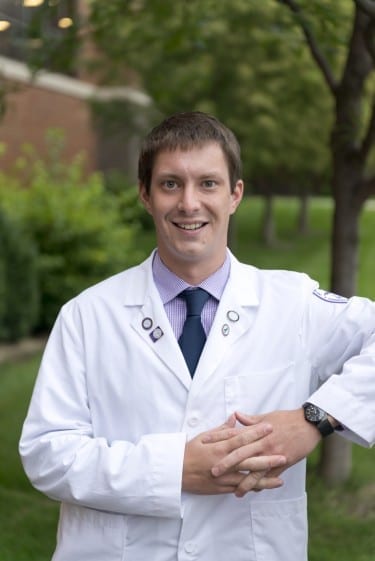
“I knew I wanted to get involved in research, and Dr. Armstrong is ‘Mr. International,’” Miller says. “I was totally blown away by his work.”
Rather than admire Armstrong’s expertise and accomplishments from afar, Miller e-mailed him and eventually traveled to SALSA to discuss how he could get involved in research. With the blessing of CPMS Dean R. Tim Yoho, D.P.M., FACFAS, Miller spent the 2013- 2014 academic year at SALSA in Tucson, engaged in interdisciplinary investigations that resulted in multiple published papers.
“Medicine in 50 years is not going to look like it does today,” he says. “Research is the gateway to what medicine will be years from now. It’s important to have that process, and it’s important to me.”
Miller was in an ideal setting for that. SALSA is a collaborative clinical and research alliance with an interdisciplinary team of clinicians, research scientists and biomedical engineers who interact with groups from across the nation and more than 50 nations on six continents. Affiliated with the University of Arizona College of Medicine, it’s the largest facility in the world dedicated to diabetic research. In addition, its clinics treat nearly 13,000 patients a year, most of whom present extremely complicated conditions.
That broad and highly engaged research environment and his own diverse clinical, research and leadership activities may be why Armstrong – who’s also a surgery professor at the University of Arizona – welcomed Miller’s contact.
“John is on a very strong path didactically, but he thought it would be a great idea to disrupt all that and take a year to conduct research,” Armstrong says. “He was totally at home with our entire ethos [at SALSA]. This is a really active, punishingly busy enterprise, and he has a high ability to be productive.”
Indeed: In his year at SALSA, Miller was coauthor of three research articles published in Wound Medicine (see below), with several more articles – some for broadly read medical journals – and book chapters either accepted for publication or in the pipeline.
“John has written more as a second-year medical student than most physicians do in their careers,” Armstrong says. “We look forward to watching him continue to flourish.”
Miller calls Armstrong a “futurist” who, with his colleagues, showed him that podiatric physicians can enhance patient well-being by doing more than treating feet. As Armstrong says, “A terminal degree should define you but not confine you. It should allow you to seek new solutions without feeling like you’re bound by some weird anatomical Mason-Dixon Line.” Working interprofessionally to treat diabetic patients, for example, podiatric physicians contribute care and knowledge relating to vascular health, wound healing and interventions to improve balance and prevent falls.
“Podiatrists at SALSA were doing all kinds of things that had nothing to do with the toe,” Miller says. “I gained perspective about what podiatry can be.”
In addition to producing research at SALSA, Miller participated in hospital rounds, care of clinic patients and surgeries. He gave and attended presentations. He and his colleagues also worked with clinicians and scientists of the Interdisciplinary Consortium on Advanced Motion Performance, or iCAMP, on ways to enhance patient interventions and outcomes using wearable sensors, virtual reality and other technologies. Those tools let them monitor a wide range of factors such as gait, balance and inflammation, often problems for diabetic patients with neuropathy of their feet.
“We could Velcro sensors to patients’ bodies, have them walk down the hall and take live data, so we had a lot of patient studies that were so easy to do live in the clinic,” Miller says. “iCAMP is a great asset.”
He’s now back at DMU, learning and practicing in the Foot and Ankle clinic. “I’m loving it,” he says. “It’s nice to be able to bring back the real-world clinic experience I gained at SALSA.”
John Miller’s published research, with more in the pipeline:
“The Diabetic-foot Online Clinic Utilization Score (DFOCUS): A calculator for estimating clinic volume and utilization” – John D. Miller, Nicholas A. Giovinco, Joseph L. Mills, David G. Armstrong. Wound Medicine 4 (2014) 19-20.
“The SALSA spike: A novel technique using Kirschner wires to anchor tenuous midfoot and forefoot amputation flaps” – John D. Miller, Natalie T. Hua, Nicholas A. Giovinco, David G. Armstrong, Joseph L. Mills. Wound Medicine 4 (2014) 13-18.
“The Too Few Toes Principle: A formula for limb-sparing low-level amputation planning” – John D. Miller, Michelle Zhubrak, Nicholas A. Giovinco, Joseph L. Mills, David G. Armstrong. Wound Medicine 4 (2014) 37-41.

